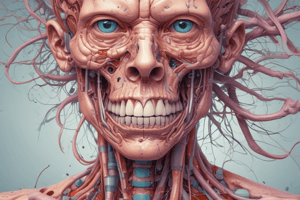Podcast
Questions and Answers
Which condition is characterized by the accumulation of fat in the liver?
Which condition is characterized by the accumulation of fat in the liver?
- Lipoma
- Hemosiderosis
- Cholestasis
- Fatty liver (correct)
Which type of necrosis is specifically associated with the brain?
Which type of necrosis is specifically associated with the brain?
- Caseous necrosis
- Liquifactive necrosis (correct)
- Coagulative necrosis
- Fibrinoid necrosis
What type of carcinoma is described as having an infiltrative growth pattern in the urinary bladder?
What type of carcinoma is described as having an infiltrative growth pattern in the urinary bladder?
- Basal cell carcinoma
- Fungating carcinoma
- Infiltrative carcinoma (correct)
- Squamous cell carcinoma
What histological feature is observed in patients with lymphocytic gastritis?
What histological feature is observed in patients with lymphocytic gastritis?
Which benign growth is primarily composed of mature fat cells?
Which benign growth is primarily composed of mature fat cells?
Flashcards
Fatty Liver
Fatty Liver
A condition where fat accumulates in the liver cells, often caused by alcohol abuse or obesity. It can lead to inflammation and liver damage.
Liquifactive Necrosis of the Brain
Liquifactive Necrosis of the Brain
A type of necrosis where dead tissue is broken down by enzymes, resulting in a soft, liquefied center. It's characteristic of brain infections.
Chloasma of Pregnancy
Chloasma of Pregnancy
A skin condition characterized by dark patches, often on the face, caused by increased melanin production during pregnancy.
Lipoma
Lipoma
Signup and view all the flashcards
Thyroid Adenoma
Thyroid Adenoma
Signup and view all the flashcards
Study Notes
Gross Lesions
- Fatty Liver: A yellowish-tan discoloration of the liver, often enlarged, appears smoother than a healthy liver.
- Liquifactive Necrosis of the Brain: A soft, liquefied area in the brain tissue. The affected brain region may have a soft consistency and a different color than surrounding healthy tissue.
- Chloasma of Pregnancy: Brownish hyperpigmentation patches commonly appear on the face but can also form on the neck and other areas.
- Freckles: Small, flat, brown spots on the skin. They are commonly located on sun-exposed areas.
- Leucoderma: Patches or areas of depigmented skin (lighter than surrounding skin).
- Jaundice: Yellowing of the skin and sclera (whites of the eyes), due to high bilirubin levels.
- Acute Appendicitis: Inflamed appendix, often appearing swollen and red, with potential pus or fluid buildup.
- Subcutaneous Abscess: A localized collection of pus under the skin, causing redness, swelling, possible warmth and pain.
- Cellulitis: Inflammation/infection of the skin that is marked by diffuse redness, swelling, heat, pain and pus.
- Keloid: Overgrowth of scar tissue that extends beyond the original injury site.
- Thyroid Adenoma: A benign tumor of the thyroid gland, often appearing as a firm, smooth, nodule.
- Lipoma: A benign fatty tumor, often mobile, painless, and subcutaneous.
- Basal Cell Carcinoma of the Face: A skin cancer appearing as a pearly or reddish growth, which is usually slow-growing.
- Fungating Carcinoma of the Tongue: A noticeably raised, ulcerated growth on the tongue surface. It's often associated with cancer spreading from other parts of the mouth.
- Infiltrative Carcinoma of the Urinary Bladder: The invasive and potentially fatal spreading of cancer that spreads into surrounding tissue and structures
- Microscopic lesions: Requires microscopic analysis- these are not easily visible by the naked eye.
Microscopic Lesions
- Hemosiderosis in Liver: Accumulation of iron-pigmented granules (brown) in the liver cells.
- Chondroma: Tumor made up of cartilage tissue, having a translucent, pinkish-purple appearance, and seen as small and translucent rounded areas, possibly in a cluster.
- Lymphocytic Gastritis: Inflammation of the stomach lining with a large number of lymphocytes (types of white blood cells) within the stomach lining.
- Lipoma (Microscopic): The presence of large amounts of fat cells (adipocytes), usually with visible cell boundaries.
- Thyroid Adenoma (Microscopic): Can be characterized by atypical/enlarged cells, with possibly irregular groupings.
- Anthracosis in Lung: Accumulation of coal dust in the lung tissue.
- Fatty Liver (Oil Red O Stain): Fat droplets appear bright reddish/orange, stained by the oil red o staining.
- Adenocarcinoma of the Colon (Microscopic): Malignant (cancer) growths characterized by abnormal gland patterns and rapid growth within tissue.
- Margination Sign in Acute Inflammation: Visible accumulation of leukocytes (white blood cells) along blood vessel walls.
Studying That Suits You
Use AI to generate personalized quizzes and flashcards to suit your learning preferences.




